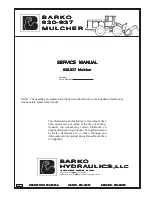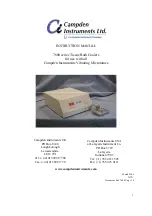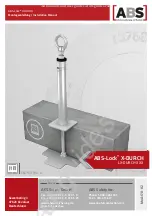
Operator's Manual
WP700Zi-OM-E-RevA
146
6. Touch
the
ERES
tab in the right-hand dialog, then touch inside the
bits
field and make an
Enhance
by
selection from the pop-up menu
Waveform Copy
The
Copy
math function
makes a copy of your present waveform in its unprocessed state. While
processing may continue on the original waveform, the copy enables faster throughput in some cases by
preserving the original data. That is, no calculations need to be undone on the copy before additional math can be
calculated.
This benefit of faster throughput, however, comes at the expense of memory usage.
Waveform Sparser
The Sparse math function
allows you to thin out an incoming waveform by skipping points at regular
intervals, and by starting acquisition at a particular "offset" (point). The
Sparsing factor
specifies the number of
sample points to reduce the input waveform by. A sparsing factor of 4, for example, tells the scope to retain only
one out of every 4 samples. A
Sparsing offset
of 3, on the other hand, tells the scope to begin on the third
sample, then skip the number of samples specified by the sparsing factor (4). In this way, the sample rate is
effectively reduced.
For the sparsing factor (interval), you can set a value from 1 to 1,000,000 points. For the sparsing offset you can
set a value from 0 to 999,999.
Note:
The maximum sparsing offset that can be entered for any sparsing factor equals Sparsing Factor 1.
Waveform Sparser Setup
1. Touch
Math Math setup
on the menu bar.
2.
Touch the tab for the function (F1 to Fx[The number of math traces available depends on the software
options loaded on your scope. See specifications.] ) you want to assign the Sparse operation to.
3. Touch
inside
the
Source1
field and select an input waveform.
4. Touch
inside
the
Operator1
field and select
Sparse
from the
Select Math Operator
menu.
5. Touch
inside
the
Sparsing factor
field and enter a value, using the pop-up keypad.
6. Touch
inside
the
Sparsing offset
field and enter a value, using the pop-up keypad.
Interpolation
Linear interpolation, which inserts a straight line between sample points, is best used to reconstruct straight-
edged signals such as square waves. (Sinx)/x interpolation, on the other hand, is suitable for reconstructing
curved or irregular waveshapes, especially when the sampling rate is 3 to 5 times the system bandwidth. The
instrument also gives you a choice of Cubic interpolation.
For each method, you can select a factor from 2 to 50 points by which to interpolate (upsample).
Setting Up Interpolation
1. Touch
Math
Math setup
on the menu bar.
2.
Touch the tab for the function (F1 to FxThe number of math traces available depends on the software
options loaded on your scope. See Specifications. ) you want to assign the Interpolate operation to.
3. Touch
inside
the
Source1
field and select an input waveform.
4. Touch
inside
the
Operator1
field, then touch the
Filter
button in the
Select Math Operator
menu.
Содержание DDA 7 Zi series
Страница 1: ...Operator s Manual WavePro SDA and DDA 7 Zi Series Oscilloscopes ...
Страница 2: ... L R R H HUD RU D D ...
Страница 41: ...Operator s Manual WP700Zi OM E RevA 40 The detachable WavePro Zi front panel ...
Страница 376: ...WavePro 7Zi 375 WP700Zi OM E RevA Absolute Offset Relative ...
Страница 439: ...Operator s Manual WP700Zi OM E RevA 438 ...
Страница 440: ...WavePro 7Zi 439 WP700Zi OM E RevA ...
Страница 544: ...Thank you for purchasing a WavePro SDA or DDA 7 Zi Oscilloscope ...
















































